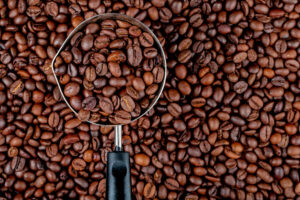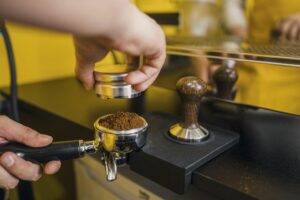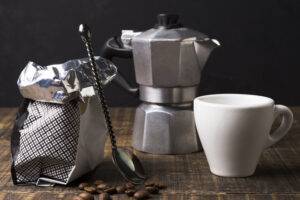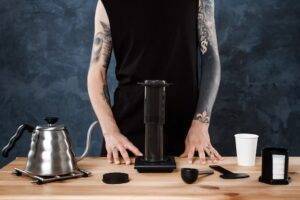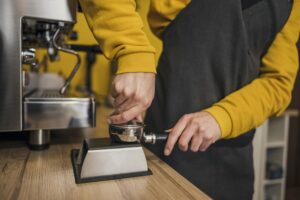
4 Criterias To Choose A Coffee Scale And How To Use It

For coffee enthusiasts, making the perfect cup of coffee is both an art and a science. From selecting the finest beans to mastering brewing techniques, every detail counts. One essential tool that often goes overlooked but plays a crucial role in achieving coffee perfection is the coffee scale. A coffee scale helps measure the precise amount of coffee grounds and water, ensuring consistency and accuracy in your brews. In this blog, we will discuss four essential criteria to consider when choosing a coffee scale and guide you on how to use it effectively to elevate your coffee brewing experience.
Accuracy and Precision
When it comes to choosing a coffee scale, accuracy and precision are paramount. Consistency in measurements is essential for replicating the same flavor profile in every cup. Look for a coffee scale with a high level of precision, preferably one that can measure up to 0.1 grams. This level of accuracy allows you to fine-tune your coffee-to-water ratio, which significantly impacts the taste and overall brewing experience.
Additionally, ensure that the scale has a tare function, which enables you to zero out the weight of your brewing vessel. This feature simplifies the process by allowing you to measure the coffee grounds or water directly into the brewing vessel, eliminating the need for multiple containers and reducing the risk of spilling.
Capacity and Size
The size and capacity of the coffee scale are essential factors to consider, depending on your brewing needs and available space in your kitchen. Some scales are compact and portable, ideal for those who enjoy brewing coffee on the go or have limited counter space. On the other hand, larger scales with higher weight capacities are better suited for home baristas who frequently brew for multiple people or experiment with different brewing methods.
A scale with a capacity of at least 2,000 grams is recommended, as it allows you to measure both coffee grounds and water for various brewing techniques, such as pour-over, French press, or espresso. Moreover, ensure that the scale platform is large enough to accommodate your preferred brewing vessel comfortably.
Brewing Timer Function
Time is a crucial variable in coffee brewing. The brewing time affects the extraction process, influencing the flavor and strength of your coffee. To streamline the brewing process and avoid the need for multiple timers, choose a coffee scale with an integrated timer function.
A built-in timer allows you to start the timer simultaneously with the first pour, helping you keep track of the brewing time accurately. This feature is especially useful for pour-over methods like the Hario V60 or Chemex, where the pouring rate and timing directly impact the flavor balance.
Durability and Water Resistance
Coffee brewing can be a messy affair, with water spills and coffee grounds often finding their way onto the scale. Therefore, it’s essential to invest in a coffee scale with a durable and water-resistant design. Look for a scale with a protective coating or a waterproof surface that can with stand occasional spills and keep the internal components safe.
Moreover, a coffee scale with a sturdy construction will ensure longevity, making it a reliable companion in your coffee-brewing journey for years to come. While some scales are made of plastic, stainless steel models are more durable and easy to clean, making them the preferred choice for many coffee enthusiasts.
How to Use a Coffee Scale Effectively for Brewing?
Now that you have chosen the ideal coffee scale, let’s explore how to use it effectively to brew the perfect cup of coffee:
Calibrate the Scale: Before every brewing session, ensure that your scale is properly calibrated. This step is crucial for accurate measurements. To calibrate, turn on the scale and press the calibration button if available. Alternatively, check the user manual for specific instructions on calibration.
Place the Brewing Vessel: Set your brewing vessel, such as a pour-over dripper, French press, or espresso portafilter, on the scale. Make sure the vessel is clean and dry to prevent any interference with the measurements.
Tare the Scale: Press the tare or zero button to reset the scale to zero. This action accounts for the weight of the empty brewing vessel, allowing you to measure only the coffee grounds or water added.
Measure Coffee Grounds: Add your desired amount of coffee grounds to the brewing vessel. For precise measurements, slowly pour the coffee grounds until you reach the desired weight. Adjust as necessary to achieve your preferred coffee-to-water ratio.
Start the Timer: If your scale has a built-in timer, start it simultaneously with your first pour. If not, use a separate timer to track the brewing time accurately.
Add Water: Slowly pour hot water over the coffee grounds, following your preferred brewing method. Keep an eye on the scale to measure the exact amount of water you add.
Monitor the Extraction: Throughout the brewing process, observe the scale readings and the timer. Aim for consistent and even extractions to achieve a balanced and flavorful cup of coffee.
Serve and Enjoy: Once the desired brewing time is complete, remove the brewing vessel from the scale and serve your delicious, well-balanced cup of coffee.
FAQs
What are the different types of coffee scales available?
a. Traditional Digital Scales: These are basic digital scales that display weight readings in grams. They often come with a tare function and are straightforward to use. They are suitable for most coffee enthusiasts and beginners.
b. Smart Scales: Smart scales are more advanced and offer additional features, such as Bluetooth or Wi-Fi connectivity to connect to coffee brewing apps. Some smart scales have built-in timers and brewing guides to assist you during the brewing process.
c. Water-resistant Scales: If you prefer pour-over brewing methods or tend to be a bit messy in the kitchen, water-resistant scales are worth considering. They provide added protection against spills and moisture.
How can I ensure accurate measurements while using a coffee scale?
a. Level Surface: Place the coffee scale on a flat, level surface to ensure accurate readings.
b. Calibration: Some scales may require occasional calibration to maintain accuracy. Check the manufacturer’s instructions for guidance on calibration.
c. Zeroing Out: Whenever you add or remove ingredients, use the tare function to reset the scale to zero. This ensures that only the additional weight is measured.
d. Consistency: To achieve consistency in your brews, use the same coffee-to-water ratio and the same brewing method each time. The scale will help you replicate the process accurately.
e. Recording Brews: If you’re experimenting with different coffee-to-water ratios or brewing methods, consider keeping a record of your brews. Note the measurements, brewing time, and any observations about the taste. This will help you refine your brewing technique.
Can I use a coffee scale for other purposes besides brewing coffee?
Yes, coffee scales are versatile and can be used for various culinary applications. They are useful for measuring ingredients for baking, cooking, and making other beverages like tea. The tare function allows you to measure ingredients without including the weight of the container, making it convenient for all types of recipes.
How do I clean and maintain a coffee scale?
a. Wipe Down Surface: After each use, wipe down the scale’s surface with a clean, damp cloth to remove any coffee residue or spills.
b. Avoid Submerging: Most coffee scales are not waterproof, so avoid submerging them in water. Instead, use a damp cloth to clean the surface.
c. Avoid Excessive Heat: Keep the scale away from direct heat sources, as excessive heat can damage its sensitive components.
d. Store Properly: Store your coffee scale in a cool, dry place when not in use, and protect it from potential damage.
Can I use a phone app as a substitute for a coffee scale?
While some phone apps claim to provide measurements for coffee brewing, they are not as accurate as dedicated coffee scales. Phone apps rely on the phone’s built-in sensors, which may not be as precise as the sensors used in specialized scales. For optimal results and consistency, it is recommended to invest in a good quality coffee scale.
Are there any special safety considerations while using a coffee scale?
a. Beware of Spills: Avoid spilling water or liquids on the scale, as this can damage its internal components.
b. Power Source: If your scale is battery-powered, ensure you have spare batteries available for uninterrupted use.
c. Child Safety: Keep coffee scales and any electrical equipment out of reach of children to prevent accidents.
Conclusion
Choosing the right coffee scale is an essential step in enhancing your coffee brewing experience. Prioritize accuracy, precision, capacity, and durability when making your selection. With the right coffee scale, you can confidently measure the coffee grounds and water, ensuring a consistent and flavorful brew every time.
Remember to calibrate the scale before each brewing session, use the tare function to zero out the weight of your brewing vessel, and take advantage of the built-in timer if available. By following these tips and techniques, you’ll be well on your way to brewing the perfect cup of coffee that showcases the true essence of your favorite beans.
Affordable and Efficient: The Best Budget Coffee Makers of 2024
Finding the best coffee maker that doesn’t break the bank can feel like a challenging quest. But with 360CoffeeMaker, we’ve simplified your search for the best home coffee maker that suits your budget. For those who prefer to brew single servings at a time, the best single cup coffee maker of 2024 is undeniably the Keurig K-Mini. Compact, stylish, and efficient, it fits perfectly in any kitchen and caters to the needs of solo coffee drinkers or households where everyone has a different coffee preference.
If you're someone who enjoys a classic brew, the best drip coffee maker of 2024 is the Mr. Coffee 12-Cup Coffee Maker. Not only is it affordable, but it's also easy to use and consistently delivers a flavorful cup. But if you're searching for the absolute best coffee maker overall, look no further than the Black+Decker 5-Cup Coffeemaker. It's affordable, efficient, and provides the perfect balance between traditional brewing methods and modern convenience. Regardless of your choice, these budget-friendly options guarantee a quality brew without the hefty price tag.

